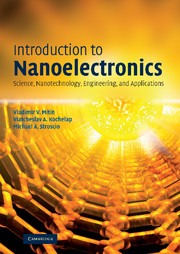Book contents
- Frontmatter
- Contents
- Preface
- List of notation
- 1 Toward the nanoscale
- 2 Particles and waves
- 3 Wave mechanics
- 4 Materials for nanoelectronics
- 5 Growth, fabrication, and measurement techniques for nanostructures
- 6 Electron transport in semiconductors and nanostructures
- 7 Electrons in traditional low-dimensional structures
- 8 Nanostructure devices
- Appendix: tables of units
- Index
1 - Toward the nanoscale
Published online by Cambridge University Press: 05 June 2012
- Frontmatter
- Contents
- Preface
- List of notation
- 1 Toward the nanoscale
- 2 Particles and waves
- 3 Wave mechanics
- 4 Materials for nanoelectronics
- 5 Growth, fabrication, and measurement techniques for nanostructures
- 6 Electron transport in semiconductors and nanostructures
- 7 Electrons in traditional low-dimensional structures
- 8 Nanostructure devices
- Appendix: tables of units
- Index
Summary
This book provides the foundations and the main ideas emerging from research that underlies the applied field called nanoelectronics. Nanoelectronics promises to improve, amplify, and partially substitute for the well-known field of microelectronics. The prefix micro denotes one millionth and, as applied to electronics, it is used to indicate that the characteristic sizes of the smallest features of a conventional electronic device have length scales of approximately a micrometer. The prefix nano denotes one billionth. Thus, in nanoelectronics the dimensions of the devices should be as many as a thousand times smaller than those of microelectronics.
Such a revolutionary advance toward miniaturization of electronics is based on the recently developed ability to measure, manipulate, and organize matter on the nanoscale – 1 to 100 nanometers, i.e., 1 to 100 billionths of a meter. At the nanoscale, physics, chemistry, biology, materials science, and engineering converge toward the same principles and tools, and form new and broad branches of science and technology that can be called nanoscience and nanotechnology.
Advancing to the nanoscale is not just a step toward miniaturization, but requires the introduction and consideration of many additional phenomena. At the nanoscale, most phenomena and processes are dominated by quantum physics and they exhibit unique behavior. Fundamental scientific advances are expected to be achieved as knowledge in nanoscience increases. In turn, this will lead to dramatic changes in the ways materials, devices, and systems are understood and created.
- Type
- Chapter
- Information
- Introduction to NanoelectronicsScience, Nanotechnology, Engineering, and Applications, pp. 1 - 10Publisher: Cambridge University PressPrint publication year: 2007



